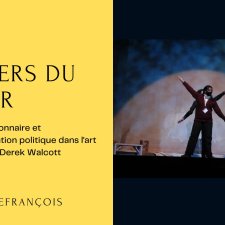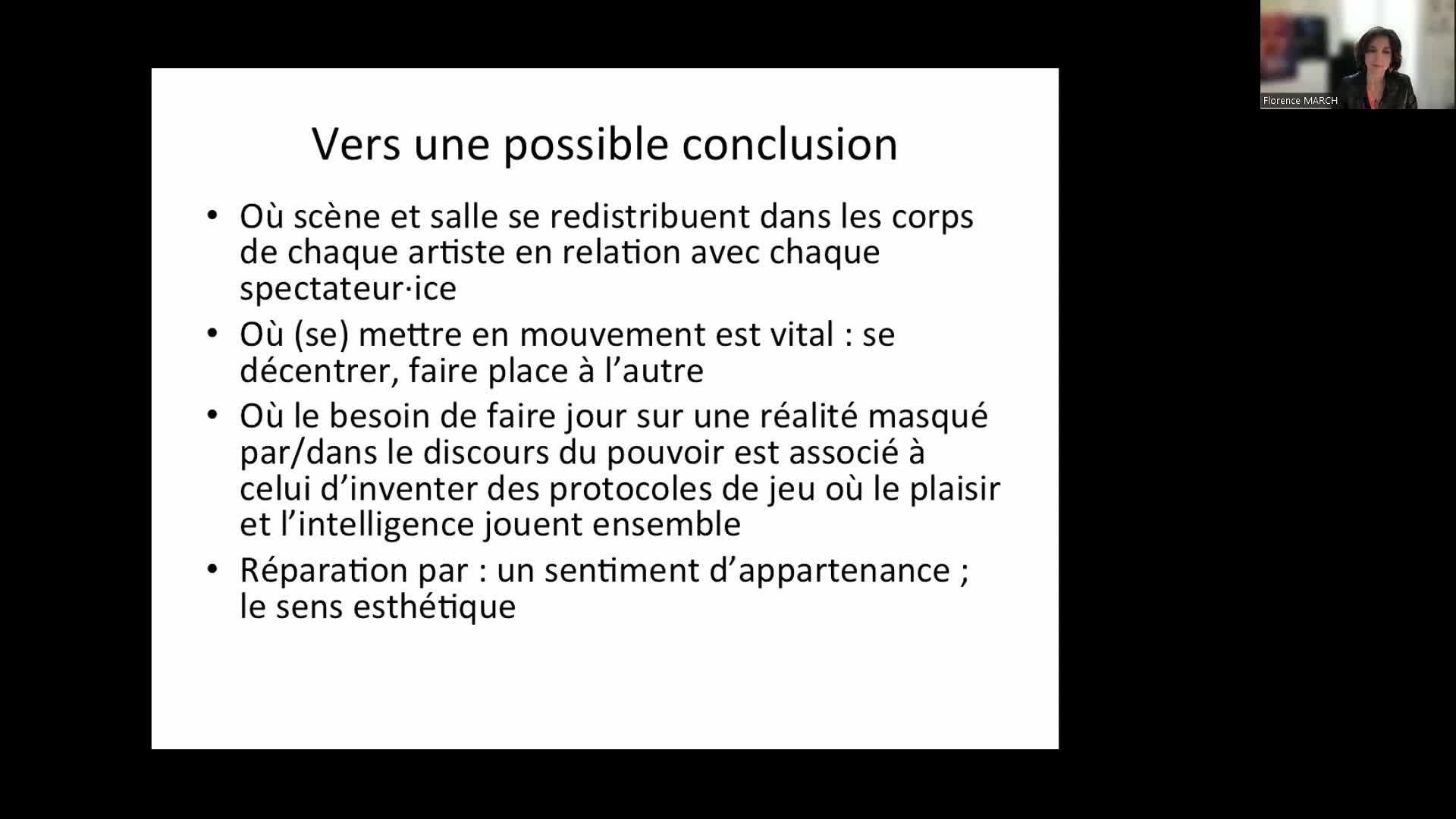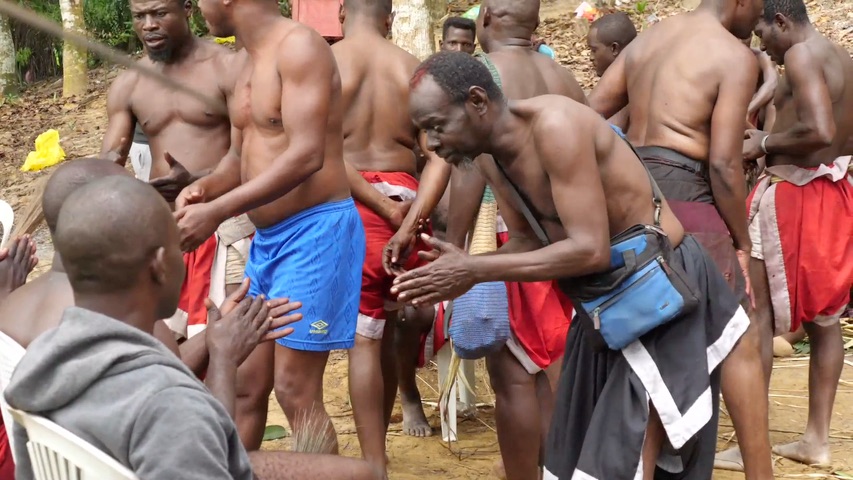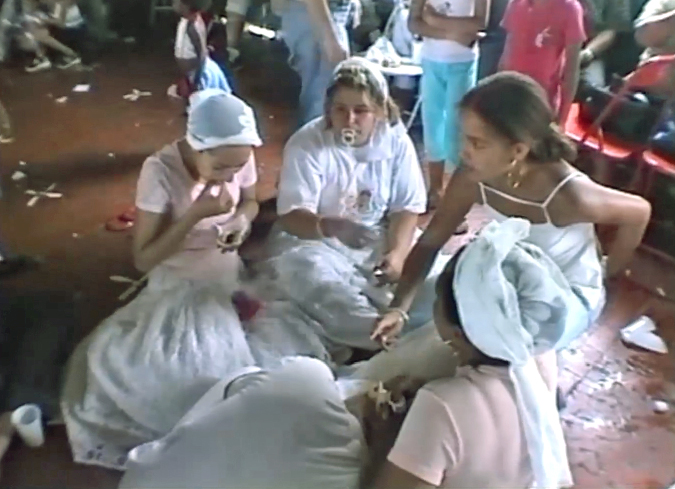Notice
“Quantifying JI” Short talk 1.3: Ashley Walton - Musical Improvisation: Spatiotemporal patterns of coordination
- document 1 document 2 document 3
- niveau 1 niveau 2 niveau 3
Descriptif
When jazz musicians perform an improvisational piece of music their behaviors are not fully prescribed inadvance. Nonetheless their actions become so tightly coordinated and their decisions so seamlesslyintertwined that the musicians behave as a single synergistic unit rather than a collection of individuals. Afundamental aspect of such musical improvisation is the bodily movement coordination that occurs amongthe performing musicians, with the embodied interaction of musicians both supporting and constrainingmusical creativity. Here we consider the ability of pairs of piano players to improvise, to spontaneouslycoordinate their actions with coperformers. We demonstrate the ability of the timeevolving patterns ofintermusician movement coordination as revealed by the mathematical tools of non linear time seriesanalyses to provide a new understanding of what potentiates the novelty of spontaneous musical action.Cross wavelet spectral analysis is applied to the musical movements of pairs of improvising pianists, amethod that isolates the strength and patterning of the behavioral coordination across a range of nestedtimescales. Additionally, crossrecurrence quantification analysis is applied to the series of notes producedby each musician to assess when and how often they visit the same musical states throughout theimprovisation. Revealing the sophistication of the previously unexplored dynamics of movement coordinationbetween improvising musicians is an important step towards understanding how creative musicalexpressions emerge from the spontaneous coordination of multiple musical bodies.
Intervention / Responsable scientifique
Thème
Documentation
Liens
Dans la même collection
-
Joint Improvisation Meetings 2015
We understand joint improvisation as an artistic form involving two or more performers engaging in multiple real-time interactions: with each other, with the audience and with the emerging content.
-
“Quantifying JI” Short talk 1.2: Tommi Himberg - Mirroring improvised hand movements in a dyad
HirataHelena SumikoWe studied coordination and movement kinematics in a mirror game. 32 participants (18 f, 14 m; mean age 25.2 years, range 19–37) performed circledrawing and freely improvised hand movement mirroring
-
“Beneficial JI” - Short talk 2.2: Julien Laroche - Being together when time is improvised: interact…
LarraínPabloImprovising music toghether involves coping in realtimewith unprecedented patterns of behavior of another. The goal is to achieve and share a meaningful coperformance,and this is done by interacting
-
“Improvising together” Debate
“Improvising together” Debate
-
Going into the unknown in science and art
KeysersChristianScientists must grope into the undefined place beyond the known. So must improvisation theater actorswalking onto the stage with no idea what will happen next. Improvisation theater developed
-
Carrying the Feeling
ManningErinCarrying the Feeling explores autistic Lucy Blackman’s use of “carrying” as an expressive force in herwriting. Continuing to delve into what I have called autistic perception theforce of perception
-
Improvising Interaction
HealeyPatrickEven the most tightly scripted solo performances involve improvisation; the detailed execution of each note or word cannot be completely determined in advance. In joint performances the challenge of
-
How much do jazz improvisers share understanding with each other and with their listeners?
SchoberMichael F.To what extent do collaborating improvisers understand what they are doing in the same way as each other?And to what extent do their listeners understand the improvisation in the same way as the
-
There could be ten seconds where everyone is connected and you feel really joined by the same threa…
CanceCarolineJoint actions require an ability to understand and predict the actions of others far enough into the future to have time to plan and execute matching motor programs. Here I will review experiments in
-
-
“Beneficial JI” - Short talk 2.3: Rachel-Shlmoit Brezis - Testing the limits – and potential of joi…
Shlmoit-BrezisRachelResearch on joint improvisation has shown that expert improvisers, as well as neurotypical individuals, canjointly create novel complex motion, synchronized to less than 180ms.
-
From me and you to we: how our brain integrates our actions and emotions when we interact
GazzolaValeriaIt is now well known that areas in the brain that are active when we act or feel become active again when weobserve other people act and express their emotions – as if we would internally relivewhat
Avec les mêmes intervenants et intervenantes
Sur le même thème
-
Danse et handicap #1 - Danser et vivre les yeux fermés : aller au bout de ses rêves
HaustantFabienneDanse et handicap #1 - Danser et vivre les yeux fermés : aller au bout de ses rêves
-
L'envers du décor: rhéthorique visionnaire et instrumentalisation politique dans l'art dramatique d…
LefrançoisFrédéricL'envers du décor: rhéthorique visionnaire et instrumentalisation politique dans l'art dramatique de Derek Walcott
-
Faire exister les nouvelles attentions : atelier de Julie Perrin et Pascale Gille
PerrinJulieGillePascalePar un atelier et une discussion, Julie Perrin et Pascale Gille soulignent comment les danseurs et danseuses continuent de faire bouger les lignes du "partage du sensible", en jouant de la frontière
-
Faire corps avec le document : les chorégraphes contemporains face aux crises et aux conflits
Cette communication se centre autour de pièces chorégraphiques qui abordent des situations de crises politiques, économiques, humaines, à travers des matériaux documentaires. Il s’agit de dresser un
-
Les formes de réparation dans les arts de la scène à l’épreuve de la Covid-19 (visio)
RiedlerJulietteBurighelGiuseppeLe webinaire propose un retour sur la journée d’étude et de pratiques artistiques " Les formes de réparation dans les arts de la scène à l’épreuve de la Covid-19 " (qui s’est déroulé le 23 mars 2022 –
-
Après la projection - Discussion autour de « Faraway My Shadow Wandered » de Liao Jiekai et Sudhee …
CheurfaCéliaJiekaiLiaoLiaoSudheeDiscussion avec les réalisateurs Liao Jiekai et Sudhee Liao, en dialogue avec Jean-Michel Butel, ethnologue, maître de conférences à l'Inalco, spécialiste des évolutions sociales et des structures
-
-
Cérémonies et rituels de l’umbanda : la fête des enfants Marília, État de São Paulo Brésil, les 13 …
JacquemotArmelleTerreiro du Vieux-noir Pai Fabiano, Marília, État de São Paulo (Brésil), les 13 et 14 octobre 2001
-
Corps dansant et corps bourgeois : la fabrique des normes au XIXe siècle
MarquerBertrandJarrasseBénédicteConférences | Vendredi 15 novembre Bertrand Marquer | La norme et l’écart : imaginaire et savoirs du corps au XIXe siècle Bénédicte Jarrasse | Corps-machines : la danse et l
-
-
-

























